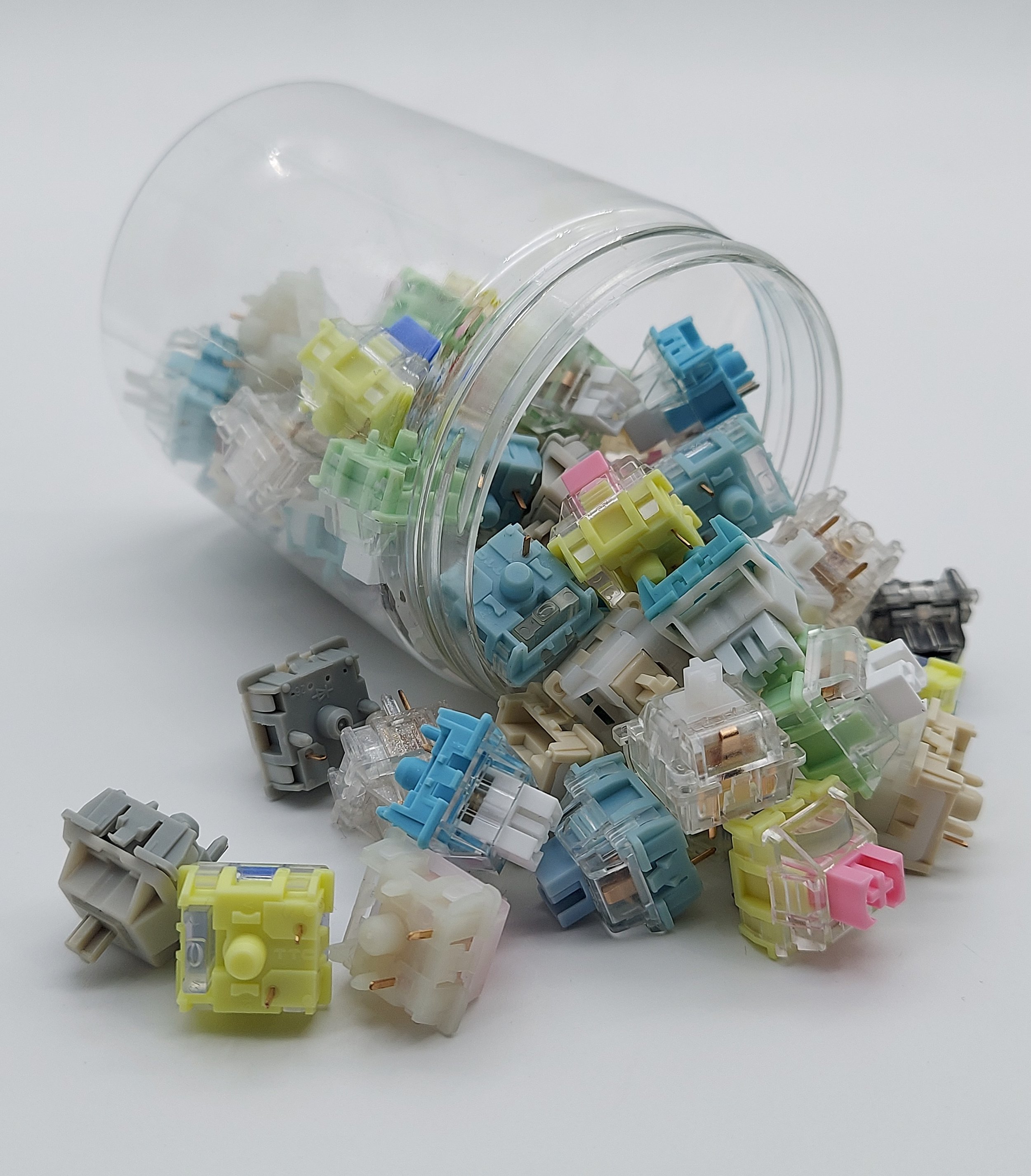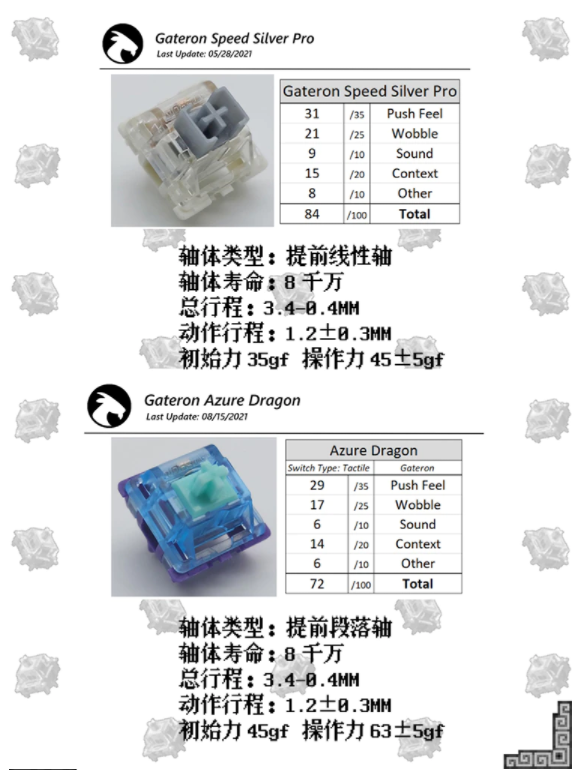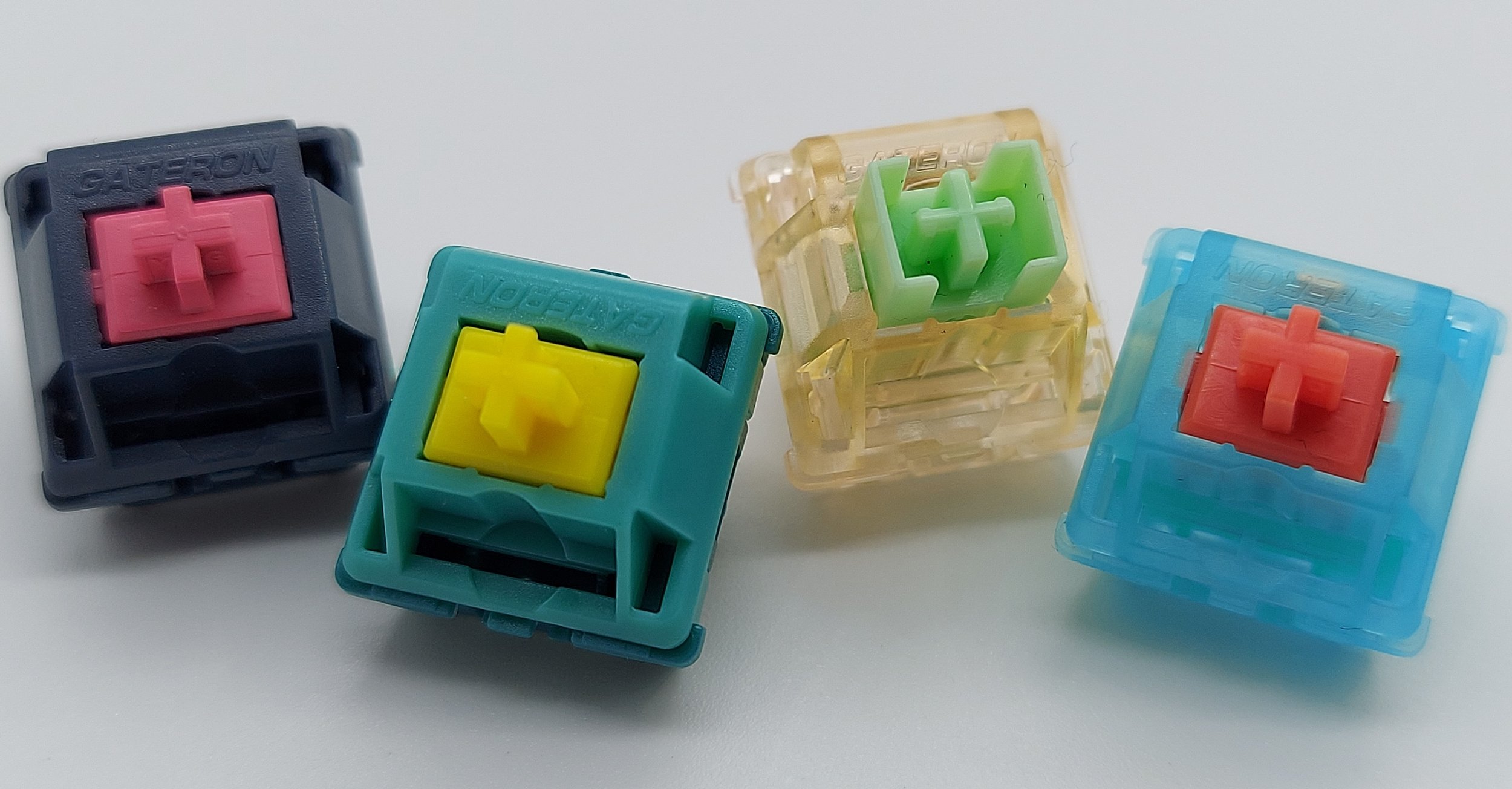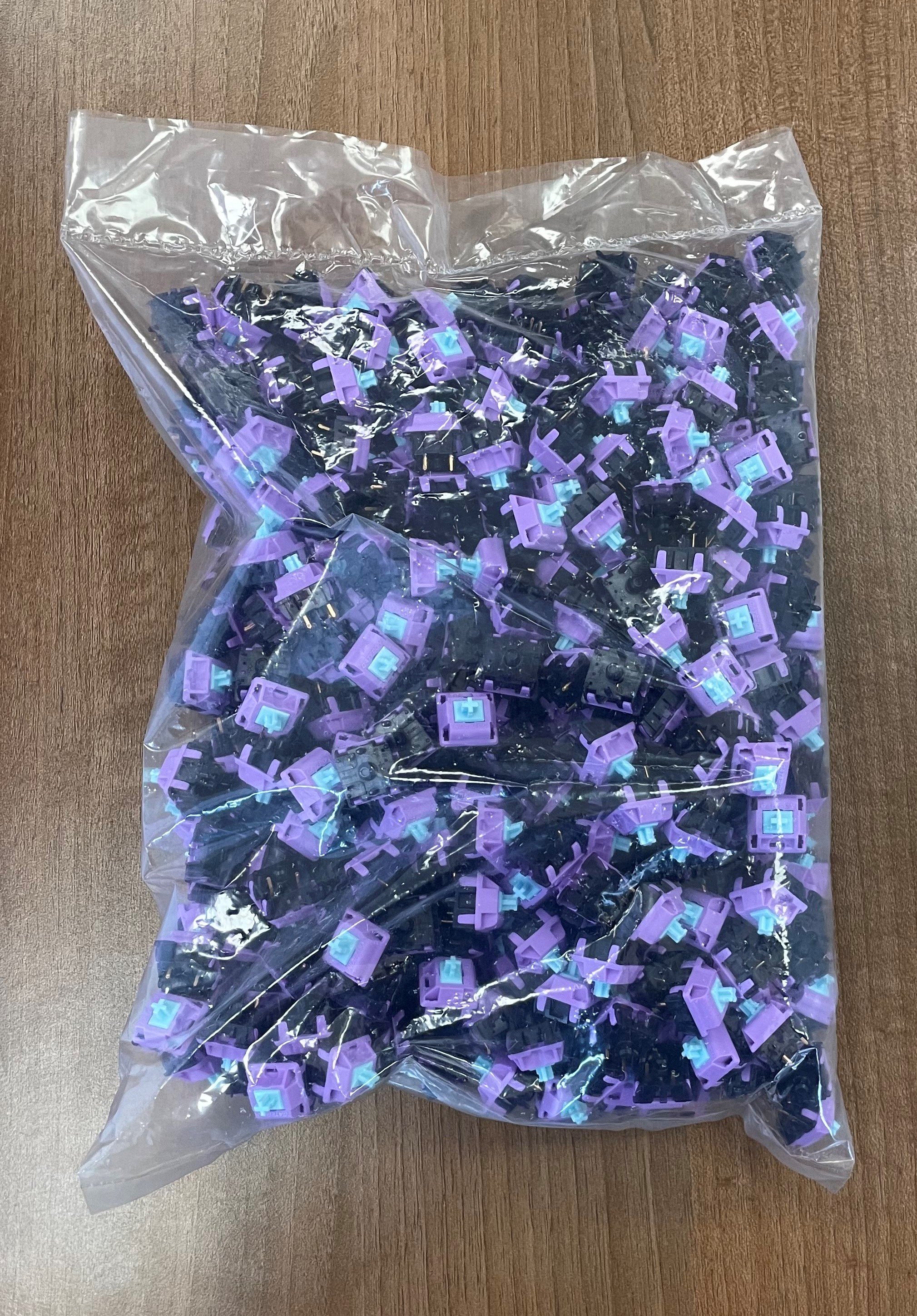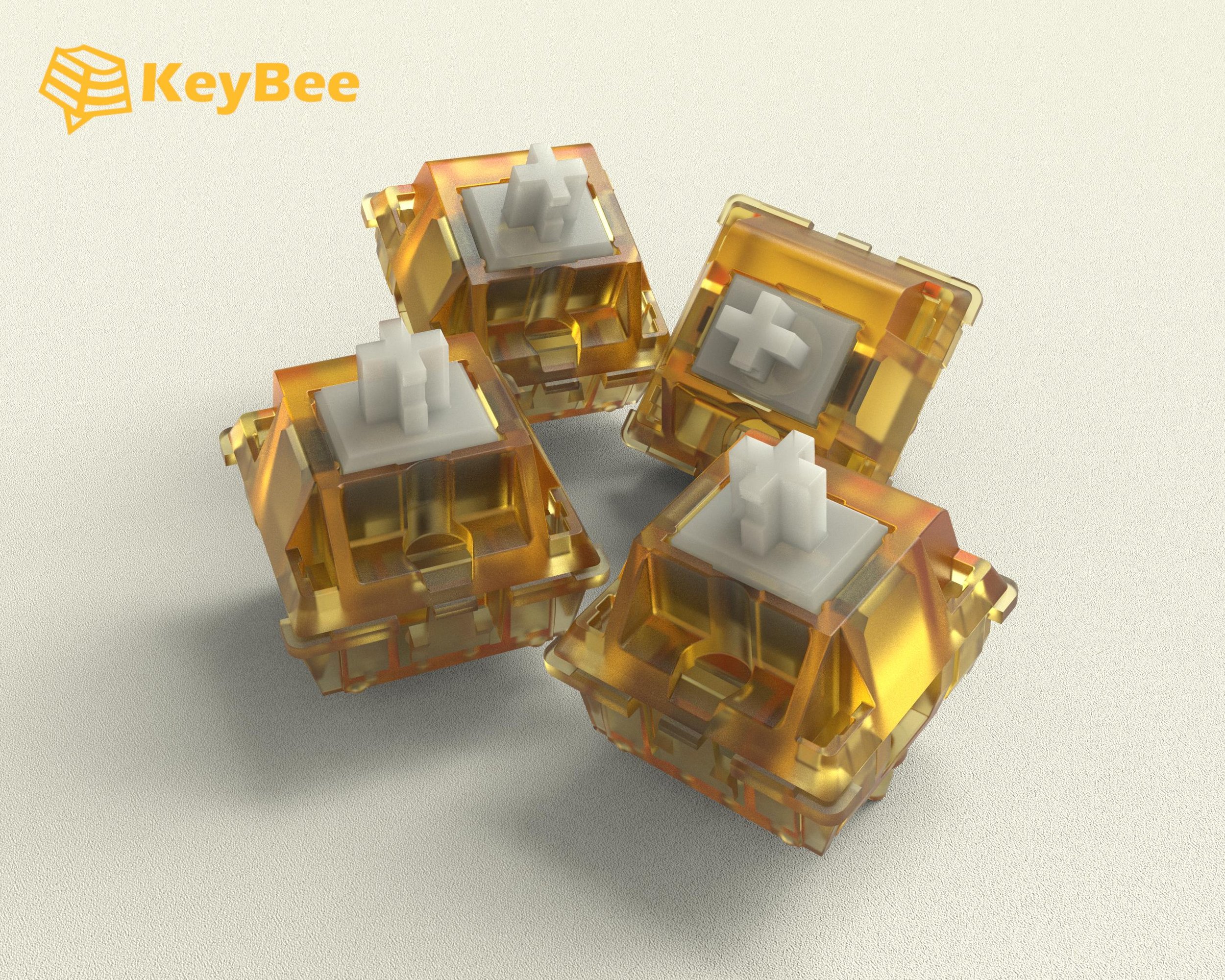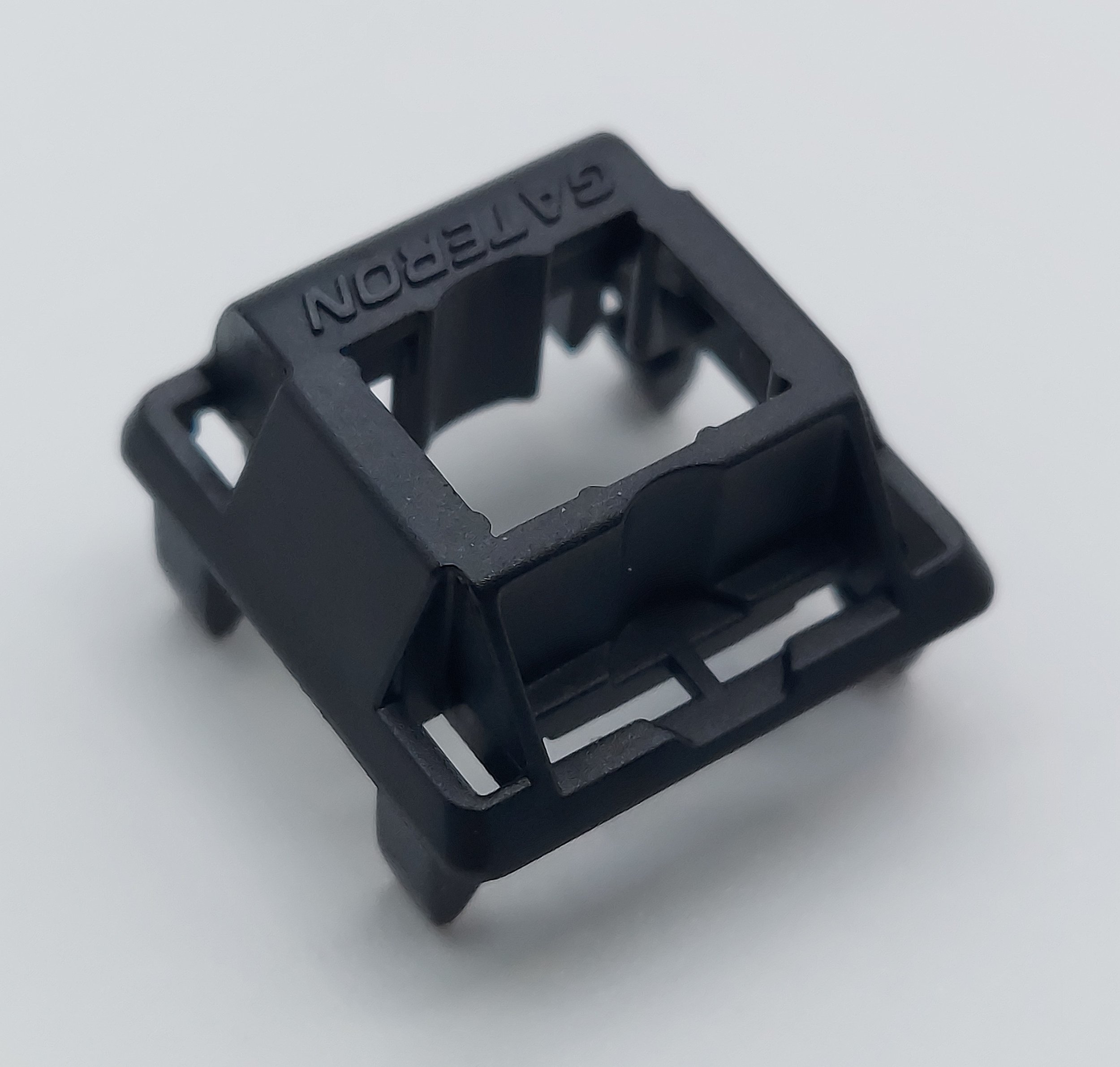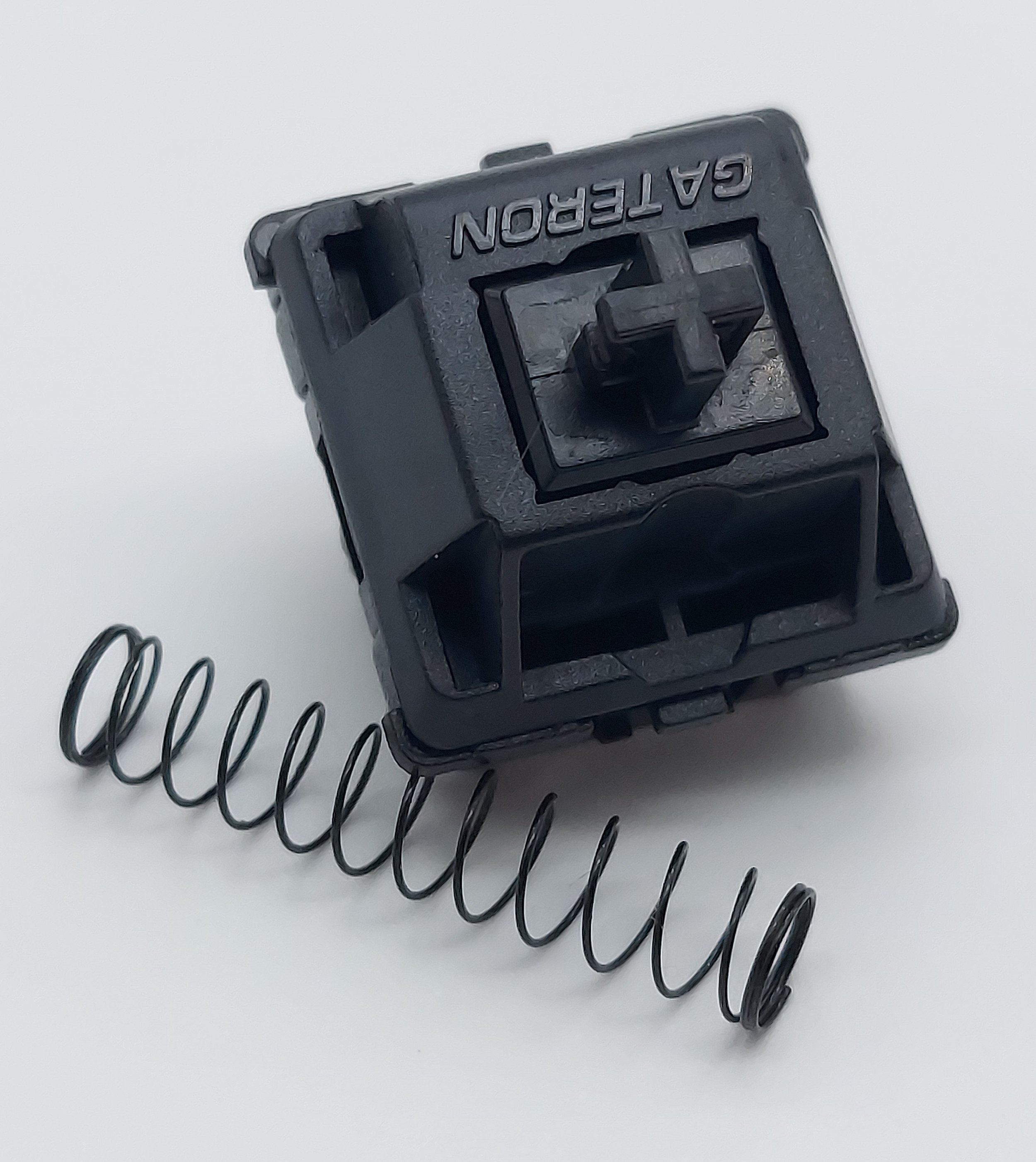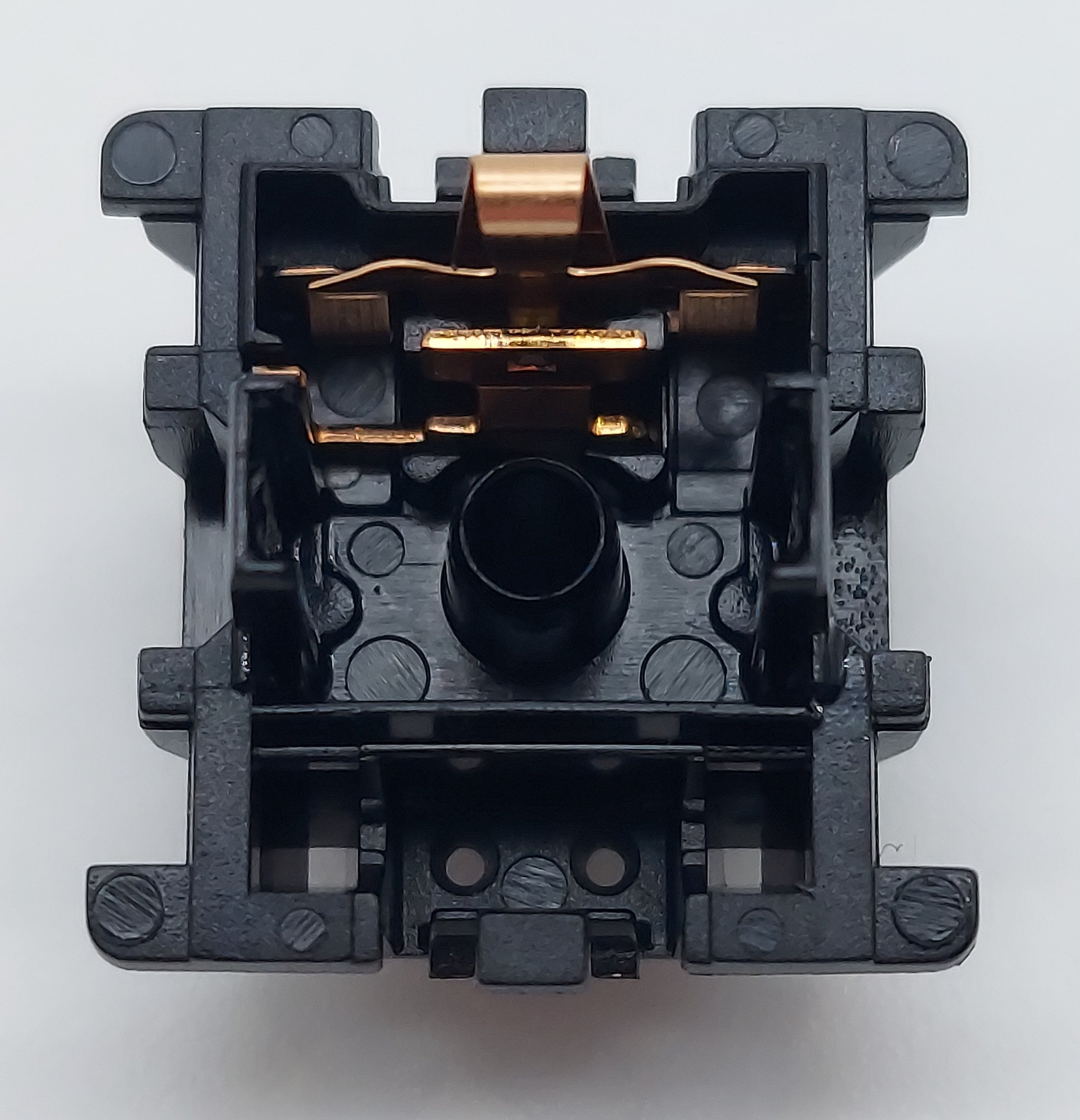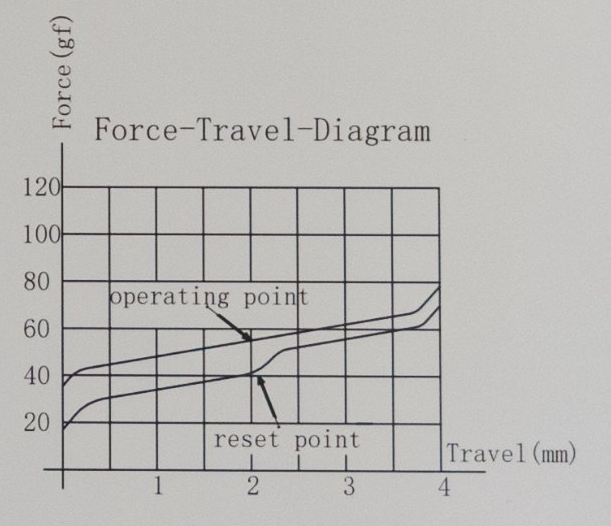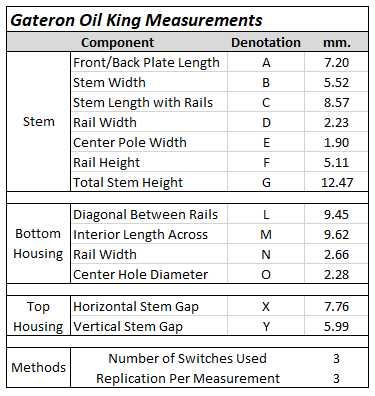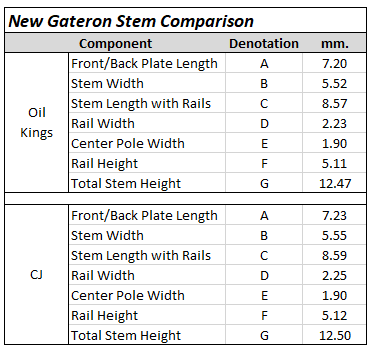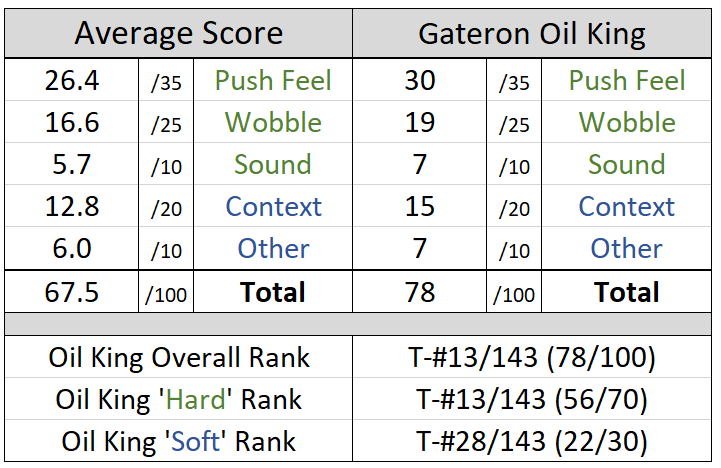Gateron Oil King Switch Review
How far are we into 2022 already? While I recognize the majority of January hardly constitutes as “far” into the year by most people’s standards, I very recently got hit with one of those mid-dating-of-a-paper crises where I realized it’s not 2016 nor even 2020 anymore and that I am in fact that old now. As well, there has been a seemingly endless barrage of switches being released by all manner of manufacturers and vendors over the past month which does help cover up the transition between the end of last year and the beginning of this one. Thanks to a slew of brand-new Zeal switches, new manufacturers and nameplates from China, a handful and change of Kailh-based releases from Chosfox, and new takes on classic switches such as Muted Box Jades, 2022 is really shaping up to be quite the year of exciting releases and switches within the MX-style footprint, alone.
Figure 1: And those are just the releases that you know about.
In addition to switches at large kicking off the year with new and interesting releases, I too have one small tidbit of news that was at least personally significant to me. Earlier this week, a user (and fellow switch collector) on the r/switchmodders Discord server linked me to a sale on Gopolar’s Aliexpress page which featured a pair of in stock, OEM style boards they were selling with Gateron Silver Pro and Azure Dragon switches. However, in addition to just selling these boards with these switches though, the description included a snippet of my scorecards for both of these switches as well as some Chinese text that I have yet to have translated. Needless to say, I was absolutely blown away that my content has reached truly that far into the Chinese scene to be posted up in an Aliexpress sales page. This is especially surprising given just how much of a black hole China has been for switches over the course of my collecting history.
While I was and still am quite giddy about the honor of being quoted on an Aliexpress sales page, a few people who had seen it reached out to me in concern initially about Gopolar doing such as it doesn’t appear as if there was a direct link back to my work. As a result of this very valid concern, I wanted to carve out the beginning of this review to remind all of you reading this that my content has always been and will always be free and openly accessible to anybody in the community who wishes to use it. Even my Patrons on Patreon, without whom I wouldn’t be able to buy and talk about so many of these awesome switches or technology which is (and will be being) used to create these reviews, don’t get any exclusive content. I’ve always wanted anyone willing and interested in providing money of any amount to do so of their own volition and not under the guise of getting access to “special” content. While I do kindly request that I get credited when I am quoted, cited, or any of my content is used in any fashion, I’m not the police and I won’t come after you over it.
In addition to the full-length reviews that I have posted here, though, I do also want to point to another few sources of content that I regularly update that may be of usage to you all here. The first, and definitely least trafficked is that of the Measurement Sheet. This sheet contains all of the switch measurements done in full length reviews as well as over 50 other exclusive switches, comparisons of each dimension by vendor, and some more fun charts for the data nerds out there among us. The next piece of content to be pointed towards is my public usage Photo Vault. This Google Drive folder contains a couple hundred photos from my Instagram, Twitter, and reviews that are completely usable by anyone for any purpose. Finally, and most recognizably to my audience at large is that of the Scorecard Repository on Github. This not only contains all of the scorecards that are shown at the bottom of long form reviews like this one, but over 75 more exclusive switches I’ve not written full length reviews on. So with these here (and all of their normal links under the ‘Archive’ tab at the top of this page), I appreciate anyone who enjoys my content enough to want to share it in any capacity and am absolutely okay with it. Do remember, though, that I am but one opinion in this very wide hobby and far from the infallible, singular voice on switches.
Switch Background
One of the subtle great points about writing reviews on very, very recently released switches is that I can shave down my time on both the researching and writing of the ‘Background’ section of them in one ultimately efficient, totally not time-crunched fashion. Given that the new Gateron Oil Kings feature Ink-housing material in the bottom housings, though, one could easily argue that I should go through and do an extensive breakdown of the entire Gateron Ink family of switches in its glorious in entirety. Gotcha, again. I’ve covered the history of the Ink switches pretty extensively and thoroughly in my Box Ink Pink switch review, already. Thus, this effectively leaves me without many switches in and around this are of Gateron’s history to discuss with the exception of the more niche, less mainline Ink-based switch options made by Gateron. Keeping up with the family analogy used to describe groups of themed switches, we may as well refer to these as stepchildren at this point.
Figure 3: Gateron Ink-ish switches. (L-R: 8008 Inks, Baltic Inks, Kangaroo Inks, Linneys)
While everyone is already intimately familiar with that of the classic Black, Slightly Quieter Black, Blue, Red, and Yellow Ink switches, above is a family photo of some of the closely related switches that fall under the Ink family tree of switches. The first two switches pictured, the 8008 Ink and Baltic Ink switches were both linear, Black Ink inspired switches that were custom ordered in conjunction with respective keycap sets of GMK 8008 and GMK Baltic. The 8008 Ink switches were the first stepchild adopted into the Ink family around August of 2020 featuring the first entirely opaque ink-material top and bottom housings with the Baltic Inks arriving around January of 2021. The third switch is that of the Kangaroo Inks, which boasts ink-material housings but literally no other similarities to that of any of the other mainline switches. While I’ve more extensively reviewed the Gateron Kangaroo Inks previously, these are highly tactile switches featuring dustproof style stems and an altogether atrocious colorway relative to literally every other single switch Gateron has ever produced. (And you can fight me if you disagree with that opinion.) The final, and most recent switch to be included in this line of Ink-family offshoots includes that of the Linney switches which have recently been prototyped and shown off on my Instagram. At the time of writing this they have not yet entered into the groupbuy phase, though they stand to be the first Ink-based switches to feature custom, non-OEM springs and are marketed as coming with pre-installed TX springs.
However, rather than stopping here at previously tread ground, I figured that I would take this even one step further than that and dredge up all of the switches that have even half Ink-material housings and even switches that have only thought of doing such. The first, and only fully released switches of this offshoot-of-an-offshoot set is that of the Gateron CJ Switches. While I’ve previously reviewed the normal, MX-mount versions and only very recently picked up the newer dustproof versions, both of these switches feature Ink material in their translucent top housings over that of POM bottom housings. Being formally announced by Gateron via Twitter all the way back in September 5th of 2021, these switches were the first to be released by Gateron featuring a mixed housing material design with one of them being made of Ink-material thermoplastic. These have additionally, and much more recently been seen in posters from Gateron’s OpenDay event in Shenzhen, China on December 18th of 2021 alongside that of their “first switch of 2022” in the Gateron Oil King switches. Interestingly, while the CJ switches were the first to feature top housings with Ink based material and bottom housings without, the Oil King switches are the first to feature the opposite, coming with Nylon top housings and Ink-material based bottom housings.
While the Gateron Oil King switches were truly the first Gateron switches to be released featuring non-Ink top housings over that of Ink bottom housings, there was in fact a switch that was announced via Interest Check back in December of 2021 with this exact combination in mind. Known as ‘Blue Bubblegum’ switches, these custom order switches by a small time vendor by the name of ‘keebhut’ were marketed on Geekhack with virtually zero response as nylon over ink-material housings with a price tag estimate of $0.75 per switch. While no further updates have been made as to the groupbuy or sales of these switches to the best of my knowledge, a photo of prototypes of these switches as received was posted on January 8th of 2022.
Figure 5: Blue Bubblegum switch samples as delivered from Gateron.
Going even further beyond this, though, there is one switch that I am aware of that originally boasted “Proprietary Gateron Ink V2 Housings” in their marketing that never made it beyond this point. First announced on March 20th of 2021, the ‘KeyBee Honey Switches’ were a 70g, linear Ink-inspired switch proposed via a hotly contested Reddit interest check featuring golden colored, translucent housings based on the initial render images as can be seen below. Due to the outrage caused by the $1.00 per switch price tag of these, which was due to the Ink-based top and bottom housings, KeyBee quickly switched these specifications not even five days later to that of a nearly half-cost switch with a polycarbonate over POM housing configuration. Beyond this interest check and a few others attempting to make these switches via Gateron, no further progress was made by KeyBee than this. The most recent interest checks of these switches seem to indicate that they are now looking to have these produced at Tecsee, as of four months ago. Look, at this point I am probably one of the only people that even remember these kinds of details so I apologize if I missed some details here or the ‘xXxFortNitexXx’ Blue Ink Gamer switches that were announced on Reddit with more downvotes than words in the post “interest check” them. Goats don’t exactly have elephant memories.
Moving back into the realm of actually released switches, the latest of the Ink-family offshoots in the Gateron Oil King switches were first seen via a Gateron Twitter post on December 21st of 2021. Coming by way of a photograph from the aforementioned Gateron OpenDay event, the Oil King switches were seen as a poster of future products alongside the CJ Dustproof switches and a set of colored, assumedly Ink-based stabilizer sets as well. Sans really any further information about them, the Oil Kings were officially announced for sale by Gateron on January 3rd of 2022, marked as the “first switch of Gateron in 2022.” These linear, Ink-based switches were released prelubed with an entirely opaque black design with a nylon top housing, Ink-material bottom housing, an 80g bottom out spring weight, and at a price of between $0.65 and $0.70 per switch depending on the vendor purchased from. Further details regarding the longevity of the stock of these switches, potential for future updates, or general extrinsic pricing/availability factors remain entirely unknown for the Oil King switches in much a similar fashion as the Gateron CJ switches.
Oil King Switch Performance
Appearance
At the broadest level, the Gateron Oil Kings are entirely opaque black, 5-pin linear switches with a design aesthetics very much in line with that of the original KS-3 Gateron linear switches. While they may share the same opacity and overall shade of black as these KS-3 housings, there’s actually quite a few noticeable differences in these switches that differentiate them from the KS-3s that doesn’t take a few thousand words to go through. First and foremost is that of the flipped ‘GATERON’ nameplate which is indicative of the newest iteration of Gateron switch molds like I’ve previously noted for switches such as the Azure Dragons and Vermilion Firebirds. Additionally, one very subtle yet interesting differentiation between these all-black linears and that of other all-black designs such as the Gateron KS3 Blacks, Cherry MX Blacks, H1s, etc., is that the texture of the exterior housing feels a bit unique. While the housings don’t quite have the purely smooth and glossy exterior of that of an H1 housing, they also don’t have the same rough, textured matte finish of that of original Cherry or Gateron Blacks either. Instead, the Oil King housings have a sort of matte-textured hybrid which is slightly more noticeable on the top housing than the bottom housing, but overall distinctly unique from what I recall having seen previously. As for further differentiable details of these switches, we will have to look closer at the molds and mold markings.
Figure 7: Textural comparison between H1s (left), Gateron Oil Kings (middle), and Cherry MX Blacks (right).
Looking first at the top housings of the Oil King switches, the exterior design already boasts a few details that make these noticeably different than that of other previous Gateron switch releases. While I’ve already mentioned the flipped ‘GATERON’ nameplate and slightly different texturing of these top housings above, the LED slot design of the Oil Kings is also relatively new in Gateron’s production history. Unlike KS-3s which feature a narrow LED slot with a circular design, and more recent Gateron releases like the Azure Dragons and Vermilion Firebirds which feature long and narrow LED slots, these switches feature a long rectangular LED slot which is bifurcated through the center with a thin strip of plastic. This was also noted in the second-to-last Gateron switch release as of the time of writing this in the Gateron CJ switches as well, potentially signaling a long-term shift in LED slot designs by Gateron. Moving internally, though, these top housings actually have one differentiating factor between them and the Gateron CJ switches. All other things seemingly equal, the Gateron Oil Kings have two, single number mold markings in the upper corners of the top housing internals underneath that of the nameplate region whereas the CJ switches only had a singular one in the top right corner.
Figure 8: Gateron Oil King top housing external design showing inverted nameplate and bifurcated, rectangular LED slot.
Figure 9: Gateron Oil King top housing internal design showing two single-letter mold markings in the upper corners.
Taking a quick detour from our normal mold-design journey, I want to take a brief second to point to the springs of the Oil King switches. Rather than the standard silver (or gold) colored springs seen traditionally in Gateron releases, these are only one of two switches from Gateron to feature that of black-colored springs, and the first of those two to be significantly longer than ‘normal’ length. While the Gateron ‘Aliaz’ switches beat out the Oil Kings to the black-colored spring game by several years, the Oil King springs are relatively different in that they have slightly tighter threading than the Aliaz springs, are rated for 80g. of bottoming out force according to the force curve diagram as seen in advertisements alongside these switches, and are also 22 mm in total length.
Figure 10: Gateron Oil King switch with stock, black 22 mm. long spring.
Moving next to the stems of these switches, they are seemingly identical to that of the previously released Gateron CJ switches on a mold marking and design feature level. These switches feature a relatively normal-length stem pole with a sub-millimeter tapered region towards the bottom, non-tapered slider rails, small mold ejector markings on the front nameplate above the stem legs of the switch, and a backplate completely clean of any markings. An additional feature I want to note here that I didn’t as thoroughly cover in the Gateron CJ switch review was that of the “sideways” injection molding point on the keycap mount of the stem. Whereas the vast majority of switches contain this on the north-side keycap stem mount, both of these switches share it on the east side, which is a detail that I can only recall for the two of them. As well, while this section has not been formally reached yet in this review, comparisons of the measurements of the stems of these switches definitely point to them being of the same mold design as the average values of each measurement point on the stems are well within tolerance standards. However, the one differentiation between these two stems comes down to the pre-applied, factory lubrication on only the Oil Kings, which is light but noticeable on only the slider rails of the stem.
Figure 11: Gateron Oil King stock lubrication demonstrated on stem.
Finally arriving to the bottom housings of the Oil King switches, this is where we see some rather notable differences between that of previous Gateron switch releases and especially that of the CJ switches. Looking first internally, the most unique feature is the placement of the eight ejector molding circles along the upper rim of the switch. Whereas many other switches from the modern era feature ejector molding circles in the corners and then on the sides or N/S edge centers of the switch, these feature the additional four mold circles briefly inside that of the corner mold markings but not in line with their common locations. To the best of my knowledge, this has not been seen previously in any other switch, much less that of a Gateron switch pointing to these being a potentially unique mold. Further evidence to the uniqueness of this mold relative to the CJ switches is that these switches feature no south-side spring collar, two pairs of mold ejector circles in the base rather than the single pair that the CJ switches have, and semi-circular shaped padded region at the bottom of the slider ails for bottoming out – all of which are unique to the Oil King switches. Externally, these subtle unique details also continue for the Oil Kings relative to that of the CJ switches. While it has been previously seen in other switches, the Oil Kings feature a pair of single letter mold markings inside of the first and fourth LED/Diode pins in addition to a sideways ‘GATERON’ stamp between the actuation pins for anti-counterfeit measures. The CJ switches, by comparison, featured these single letter mold markings significantly higher up and closer to that of the PCB mount pins than that of the Oil King switches.
Figure 12: Gateron Oil King bottom housing internal design showing mold markings, padded bottoming out regions, and mold ejector marks along the upper rim.
Figure 13: Gateron Oil King bottom housing external design showing mold markings and ‘Gateron’ anticounterfeit stamp.
Push Feel
One of the biggest reasons people have long sought out opaque-black housing linears, be them KS-3s from Gateron, Cherry, or any of the other recent attempts at these from newer manufacturers is plain and simply how solid and “thick” they feel. Typically, these housings with this aesthetic tend to be nylon based and thus carry with them a certain ‘je ne sais quoi’ that produces a thicker, fuller, and more solid set of housing collisions than that of polycarbonate or POM-based housings. To that end, the Gateron Oil Kings are incredibly effective at exactly nailing the depth of feeling desired in these type of switches even with the Ink-material thermoplastic being the composition of the bottom housing. At either end of the linear stroke, the housing collisions of these switches are firm, solid, and muted with the topping out being (as usual) a bit thinner than that of the bottoming out. As a result of the fact that the top housing is made of nylon whereas the bottom housing is made of Ink-material thermoplastic, I’m almost certainly willing to chalk up this topping out thinness to that of a mechanical difference in the thickness of the housings rather than that of a material-based difference.
As for the smoothness of these switches, Gateron has yet again demonstrated that this newest introduced lubing technique is excellent both in terms of switch-to-switch consistency as well as per-switch smoothness. While it is not confirmed to be a one-to-one correlation, the presence of the inverted ‘GATERON’ nameplate has seemed to correspond to switches that were produced with the new, improved factory lubing technique that Gateron and the Oil Kings will continue to further support this claim. Other linears to feature this improved smoothness and inverted nameplate design – Gateron Pro Silvers, Gateron Pro Reds, Gateron Vemilion Firebirds – all have the same level of smooth but not overlubed feeling as the Oil Kings, which would make them more than likely to be ‘usable as stock’ for many people new to the hobby. As for the consistency, approximately 1 in 10 of the switches I tried in my batch felt slightly thinner than that of the other switches, but not to such an extent that I would altogether not use them in a build if I was building a full board with these switches. Overall, the push feel of these switches regarding the smoothness is a rather impressive and continued demonstration of Gateron’s willingness to improve their switches to that of modern, enthusiast grade standards even if only incrementally over time.
Figure 14: Gateron Oil King force curve diagram as stolen from high-resolution OpenDay tour photography.
Sound
As for the sound of the Oil King switches, this is unfortunately the area that I feel like Gateron still needs to improve on the most, but not by all that much. While there is no scratch sound nor spring ping in any of the switches that I received in my batch, inconsistencies in the topping out sound were much more noticeable than any inconsistencies in feeling with factory lubing. On average, the topping out of these switches tends to be rather flat, medium-high pitched, and with a sort of ‘slappy’ tone to them compared to something more sharp and plasticky like that of polycarbonate top housings. In about 4 in 10 of the switches that I tried though, the topping out sound was slightly more muted and marginally lower pitched than that of the other switches. While this effect does diminish slightly when under keycaps and in a more solid sounding keyboard, housings and keycap choices which amplify sound would definitely make these differences in stock topping out more noticeable. As for the bottoming out, though, they are surprisingly consistent with a thick, muted, and significantly less noticeable sound relative to that of the topping out of the switch.
Wobble
Interestingly, while there does appear to be differences in the measurements between the top housing openings in the Oil King switches and that of the Gateron CJ switches, there doesn’t appear to be all that much difference in the stem wobble of the two switches. The Gateron Oil King switches have a potentially problematic amount of stem wobble in both the N/S and E/W directions that is not altogether uncharacteristic of Gateron but still significantly improved over that of previous offerings from the company. Problems with this wobble would likely arise in the event that the person using them is particularly sensitive to wobble or the build with them contained tall keycaps, such as SA profile, which would amplify the stem wobble. Comparing the Oil Kings head-to-head with the CJs even though this isn’t the comparison section, the Oil King switches feel perhaps a hair bit more wobbly especially in the N/S direction, but I’d argue that the vast majority of people would definitely not notice this difference in a build. As well, there is absolutely no top housing budge in these switches even after having opened and closed them several times with a switch opener.
Measurements
If you’re into this level of detail about your switches, you should know that I have a switch measurement sheet that logs all of this data, as well as many other cool features, that can be found under the ‘Archive’ tab at the top of this page or by clicking on the card above. This sheet typically gets updated weekly on mail days, and has been a subtle project I’ve been developing for some time now!
Brief comparison of the stem measurements between the Gateron Oil Kings and CJ switches to further support the aforementioned claim that these were likely created from the same stem molds.
Comparison Notes to Other Notable Linear Switches
Note – These are not aimed at being comprehensive comparisons between all factors of these switches as this would simply be too long for this writeup. These are little notes of interest I generated when comparing these switches to the Oil Kings side by side.
Figure 17: Switches for comparison. (L-R, Top-Bot: Cherry MX Black, Opblack, Gateron CJ, H1, KTT Strawberry, Gateron 8008 Ink)
If you would like to learn more about these switches, I’ve already completed reviews or scorecards for some of them. If the names below are highlighted in a grey color, click them to be taken to my other content or reviews on them!
Cherry MX Black
- In terms of overall volume, the Cherry MX Black is definitely more quiet and bass-heavy than that of the Oil King switches. In addition to this holding true for both bottoming out and topping out, I do want to point out the prevalence of scratch in the sound of the MX Black that isn’t noticeable in the Oil Kings at all.
- The stem wobble in both the N/S and E/W directions of the Oil King switches is by far significantly better than that of the Cherry MX Black switches.
- While the springs of these two switches are rated +/- 5g of each other at both actuation and bottoming out, the Cherry MX Blacks still feel a tad bit more heavier and solid than that of the Gateron Oil King switches.
Opblack
- The Opblack switches are far and away louder than that of the Oil King switches at topping out, and this gap only widens further with faster actuation speeds as the Opblacks pitch up in sound with increased speeds.
- In terms of smoothness, these switches are definitely comparably smooth, though the Opblack switches feel a bit more as if they have the ‘true character’ of the switch whereas with the Oil Kings you get more of a slightly ‘hand lubed’ feeling.
- The stem wobble in both directions in the Oil King switches is better and less noticeable than that of the Opblack switches.
Gateron CJ
- The Gateron CJ switches are marginally louder than the Oil Kings at topping out, and have a slightly higher-pitched sound than that of the Oil Kings. It should also be noted that across a small batch of both of these switches that the CJs had a slightly more consistent sounding topping out to them, even if they were not all that great sounding.
- Overall, the Oil King switches feel more solid, cohesive, and perhaps hand-lubed than that of the CJ switches. While I normally use this in a negative sense in that switches that feel ‘hand-lubed’ are more gummy or overlubed, in a subtle way its definitely makes the switch feel more unique and smoother than the CJ switches.
- In terms of both sound and feeling, the bottoming out of the Oil King switches is significantly better than that of the CJ switches.
H1
- The H1 switches are slightly more grainy and scratchy than that of the Oil King switches. While the H1s were definitely competitively smooth at the time of their release a few years ago, it really comes to show just how much factory lubrication techniques have improved across the board over the past few years, regardless of the manufacturer.
- The bottoming out of the H1 switches is significantly more muted, dampened, and subtle than that of the Oil King switches, but not by all that much.
- Surprisingly, the stem wobble on the H1 switches has also not stood the test of time and is slightly greater in both the N/S and E/W directions than that of the Oil King switches.
KTT Strawberry
- Of any of the switches on the list, the KTT Strawberries are surprisingly the most similar sounding to the Oil Kings in both terms of overall volume as well more specific characteristics such as pitch, sharpness, etc.
- Overall, the KTT Stawberry switches definitely feel smoother throughout the stroke than that of the Gateron Oil King switches, though the lube is noticeably thicker in the Strawberries than the Oil Kings.
- The stem wobble of the KTT Strawberry switches definitely still does outclass that of the Oil King switches, and really the vast majority of switches that Gateron has ever produced for that matter.
8008 Ink
- The 8008 Ink switches are both significantly louder and more thin, sharp, and plasticky sounding at topping out than that of the Oil King switches. While the bottoming out is a bit ‘better’ and more in line with the general public’s expectations of Ink-housing material, it still doesn’t compare in depth and solidness to the Oil Kings’ bottoming out.
- The stem wobble, and especially that in the N/S direction is better in the Oil Kings than the 8008 Ink switches, which really stands to highlight the mold and design-based improvements that Gateron has made in the past few years.
- In terms of smoothness, the 8008 Inks have a consistent-grain scratch feel that is subtle, albeit significantly more noticeable when comparing side by side to that of the Oil King switches.
Scores and Statistics
Note – These scores are not necessarily completely indicative of the nuanced review above. If you’ve skipped straight to this section, I can only recommend that you at least glance at the other sections above in order to get a stronger idea of my opinion about these switches.
Push Feel
With an impressively consistent and not over the top factory lube application, these nylon over Ink-material heavy linear switches really push the boundaries of what people can ask for in a traditional ‘black’ linear switch. The firm, muted bottoming out only further adds to the smoothness, weight, and overall feeling of these switches with perhaps just a hair too thin topping out holding these back from being near perfect.
Wobble
Much like with the recent releases post-mold update from Gateron, these switches feature a noticeable amount of stem wobble in both directions, but altogether unlikely to bother most users unless their build exasperates this feature. As for top housing wobble, there is absolutely none even upon opening and closing the switches multiple times.
Sound
Following in line with the Push Feel notes almost to a ‘t’, these switches have a firm, solid, and overall bass driven sound that is very reminiscent of your favorite all-black linears. Unfortunately, though, the small hang up in the thinness of the topping out is only exasperated here with greater batch-wide variability than one would like to see.
Context
Coming on the heels of already great releases in the GoPolar Gateron duo as well as the CJ switches, the Oil Kings definitely are more demanding of their mid-tier release price tag at $0.65 a switch. Based on all the above features and slightly greater day one availability, I anticipate these will be one of the bigger hits of Gateron in recent times.
Other
Further commanding of this price tag and praise is Gateron’s willingness to commit to the long spring designs debuted in the Gateron Pro Silver line of switches. These definitely seem like a strong design and the choice to tweak these before full diving-in on the design is commendable.
Statistics
If you are looking at this statistics section for the first time and wondering where the hell are the other 142 switches that I’ve ranked are, or what ‘hard’ versus ‘soft’ ranks refer to specifically, I’d encourage you to head on over to my GitHub linked in the table above or at the links in the top right hand of this website to check out my database of scorecards as well as the ‘Composite Score Sheet’ which has a full listing of the rankings for each and every switch I’ve ranked thus far.
Final Conclusions
Being the first true switch release of 2022 by Gateron, the Oil King switches have several details which I both had and hadn’t anticipated prior to actually getting them into my hands to test. Following an overwhelmingly positive community response with respect to recent switch improvements as seen in the new Pro line of switches, the GoPolar duo, and the CJ switches, I was not altogether surprised that the first release of the new year would continue on with these improved techniques. That being said, though, my checklist of soon-to-come expectations for Gateron certainly did not include an all-black heavy linear switch, a mixed housing material scheme, nor an interestingly colored and long spring. And that list of expectations was written with the idea of these being features in separate switches, much less all in one. Further surprising me as to these points, though, was how solidly executed all of these features were by Gateron in the Oil King switches even baring in mind the slight issues that need improvements still.
While its relatively hard to tell what exact direction Gateron is trending with their releases, such as whether or not we will continue to see further integration of the Ink family of switches and their characteristics into mainstream releases, these definitely do point to an overall positive and competitive year for Gateron. This competition may even be on par with smaller, more agile manufacturing outfits in China and not just other major release companies such as Outemu and Kailh. Personally, I’m a rather big fan of how these switches turned out and could very easily see myself using them in a build when I discover some of that elusive ‘free time’ thing people keep talking about. Outside of just my opinion, though, I wouldn’t be entirely surprised if these take off with some pretty solid community acceptance and enjoyment. While I recognize that some part of this delay in community willingness to try switches out is due to the lack of coverage by content creators, streamers, or other people-of-note with opinions in this community, I do think these switches are worth checking out for many people and are a great success for Gateron. Fuck digging for gold, Gateron struck oil.
Sponsors/Affiliates
Mechbox UK
- A wonderful UK based operation which sells singles to switches that I’ve used above in my comparisons for collectors and the curious alike. Matt has gone out of his way to help me build out big parts of my collection, and buying something using this link supports him as well as my content!
KeebCats UK
- A switch peripheral company based out of the UK which sells everything switch adjacent you could ask for, they’ve been a huge help recently with my film and lube supply for personal builds, and they want to extend that help to you too. Use code ‘GOAT’ for 10% off your order when you check them out!
proto[Typist] Keyboards
- An all-things keyboard vendor based out of the UK, proto[Typist] is a regular stocker of everything from switches to the latest keyboard and keycap groupbuys. While I’ve bought things from the many times in the past, they also are a sponsor of my work and allow me to get some of the great switches I write about!
MKUltra Corporation
- We may have stolen a few government secrets to get this one together. MKUltra is a US vendor that truly fills all the gaps other vendors simply don’t offer and is continuing to expand their switch and switch related peripherals by the day. Use code ‘GOAT’ for 5% off your order when you check them out!
Divinikey
- Not only do they stock just about everything related to keyboards and switches, but they’re super friendly and ship out pretty quick too. Divinikey has been a huge help to me and my builds over the last year or two of doing reviews and they’ll definitely hook you up. Use code ‘GOAT’ for 5% off your order when you check them out!
ZealPC
- Do they really need any introduction? Zeal and crew kicked off the custom switch scene many years ago with their iconic Zealios switches and the story of switches today couldn’t be told without them. Use code ‘GOAT’ (or click the link above) for 5% off your order when you check them out!
Further Reading
Divinikey Oil Kings Sales Page
PrevailKeyCo Oil Kings Sales Page
PXL SG’s Gateron Oil King Quick First Look
Mekibo Gateron Baltic Ink Sales Page
KeyBee Honey Switch First Interest Check
